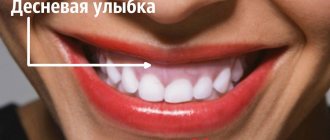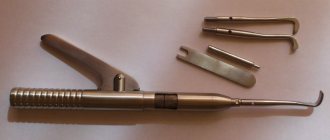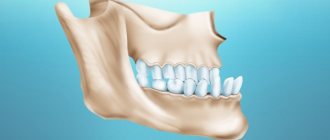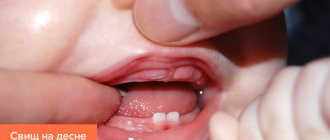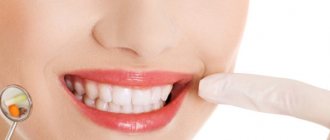Go straight to:
- When is gum surgery necessary?
- Methods for gum extension
- Gingivoplasty for unaesthetic smile shapes
- Progress of the operation
- Postoperative recovery
- Cost of surgery in Moscow
The gums are a part of the oral cavity that plays a very important role, but is often forgotten or not given due importance. Gums protect the neck of the teeth from harmful or traumatic factors, fix the tooth itself, and give the smile a beautiful shape.
Gum augmentation is a procedure during which the shape of this formation is changed in order to cover the exposed area of the tooth or correct it around the implant.
The shape of the gums can change after dental interventions, injuries, inflammatory processes (gingivitis, periodontitis) or due to congenital structural features of the jaw, its developmental anomalies, which are easily corrected with gingivoplasty. Gum plastic can prevent or eliminate an aesthetic defect and give the desired appearance to any gum.
When is gum surgery necessary?
Like any other surgical intervention, gingivoplasty has its own indications. It is carried out in the following cases:
- Gum plastic surgery when the root is exposed (recession). One of the most important and common indications for this intervention. Closing gum recession is necessary to prevent tooth decay, reduce its sensitivity, and reduce the risk of developing infectious and inflammatory complications;
- Correction of a gummy smile. Exposing mostly the gums, rather than the teeth, while smiling can be embarrassing for both those around you and the person himself. In such cases, gum plastic will do an excellent job of eliminating the defect, and additional production of veneers will be able to correct any non-standard situation;
- Gum augmentation with implantation or bone grafting. It is produced to cover the bone tissue being built up, fix the implant, and eliminate aesthetic defects;
- Elimination of the consequences of gingivitis or periodontitis. During the development of these pathologies, the neck or root of the tooth is often exposed. Treatment of gum recession is intended to be a necessary element for getting rid of and further preventing the infectious and inflammatory process.
Why is vestibuloplasty needed?
Dentists at Dr. Granov’s clinic recommend vestibuloplasty for the following purposes:
- treatment and prevention of periodontal tissue diseases. After the operation, there is a significant acceleration of the processes of tissue regeneration and relief of inflammation in the gums;
- ensuring reliable fixation of dentures and successful implantation;
- increasing the effectiveness of bite correction measures;
- prevention of gum recession, that is, exposure of tooth roots;
- improvement of articulation of labiodental sounds;
- as a preparatory stage before flap operations to cover exposed tooth necks.
Experience and professionalism!
In our clinic, vestibuloplasty is performed quite often and very successfully, so our specialists have significant experience in this field.
Leave your phone number. The clinic administrator will call you back.
By leaving a request on the site, you consent to the processing of personal data
Make an appointment
Consultation with a periodontist
400 rub.
Methods for gum extension
There are two ways to perform gingivoplasty: using your own flap of the oral mucosa or using a special collagen matrix or barrier membranes.
Patchwork is more common due to the fact that it does not require additional products in the form of a collagen matrix. This technique uses only the patient's own tissue:
- An incorrectly located area of the gum is excised, unable to return to its original position;
- If there is a lack of tissue available at the excision site, a tissue flap is formed from adjacent areas of the mucosa (adjacent gum, palate, inner surface of the cheek);
- The flap or gum edges are sutured under tension in close contact with the tooth surface using surgical knots.
The use of a collagen matrix is somewhat different. The material is simply tightly sewn to the existing defect, which ensures the subsequent formation of its own tissues on the existing collagen mesh.
What happens if you don't have surgery?
- Due to the too shallow vestibule, the periodontal tissues are strongly stretched and the roots of the teeth are exposed.
- When swallowing, the tone of the mental muscles increases.
- Lips move with difficulty.
- While chewing even relatively soft food, the gums are injured, and infection gets into the wounds. Inflammation and formation of periodontal pockets begin.
- The blood supply to the gums is disrupted, and the process of atrophy of periodontal tissues begins.
- The risk of developing dental pathologies increases.
- An incorrect bite is formed.
- Jaws develop at different rates.
- Teeth become undesirable.
- Speech becomes slurred due to impaired articulation of sounds.
- A strong unpleasant odor appears from the mouth.
Gingivoplasty for unaesthetic smile shapes
There are two common types of smiles that do not fit into modern concepts of beauty:
- Gummy smile. With this type of smile, several millimeters of gum, most often the upper one, are exposed. This gives the face an unusual, “horse” expression when smiling.
- Shark smile. During inflammatory processes in the oral cavity (gingivitis, periodontitis), soft tissue grows and gradually layers on the teeth. This visually reduces their size, creating the impression of a shark grin or smile.
Both gummy smile correction and shark smile correction are performed by excision and modification of excess soft tissue. Thanks to this, the smile and gum contour are given an aesthetically correct shape.
Gingivectomy is also used when wisdom teeth erupt or after their removal, when there is excess gum tissue after installing a dental implant, bite adjustment, or tooth extraction.
Causes of a gummy smile
It is rare for a gummy smile to appear in adulthood; most often it develops in childhood. The cause of a child's gummy smile can be either an upper lip that is too short, which simply cannot cover the gum when he smiles, or a gum that is too large, covering the teeth more than it should. In dentistry this is called gingival hyperplasia. A pronounced gummy smile is most often the result of an anomaly of the facial skeleton or a malocclusion, in which the middle zone of the face is enlarged, and the upper incisors are shifted downward or pushed forward. This problem can also be aggravated by gaps - too large gaps between the front teeth.
Progress of the operation
Gingivoplasty is conventionally divided into several stages:
- Preparing for the intervention. The oral cavity is disinfected using antiseptics or other disinfection methods. If necessary, the surgical field is delimited from other areas of the mucous membrane;
- Anesthesia. Most often, local infiltration anesthesia is used using any modern painkillers or other anesthetics approved by an allergist. Less commonly, conduction anesthesia is performed with blockade of the maxillary or mandibular nerve;
- Tissue dissection. Necessary incisions and excision of excess soft tissue are made;
- Directly plastic. It is possible to directly stitch the incision after removing excess gum, form a flap, or use a collagen matrix with their fixation to the surrounding tissues;
- End of operation. The surgical wound is sutured with surgical sutures.
Such an operation lasts within 30-60 minutes from the start of preparation to its complete completion. Plastic surgery using a collagen matrix is performed on average 10-15 minutes faster. A modern laser can be used to cut tissue, which significantly speeds up the rehabilitation period.
Why do we recommend laser surgery?
Laser vestibuloplasty has a number of obvious advantages over classical methods of expanding the vestibule of the oral cavity.
- It is possible to perform plastic surgery on both jaws and significantly increase the area of fixed gums.
- Minimally invasive and safe procedure.
- Postoperative swelling goes away very quickly or is absent altogether.
- Pronounced antibacterial effect.
- Strict locality of the laser beam impact.
- Minimal risk of bleeding, infection and the formation of postoperative scars.
- Rapid tissue restoration.
- Possibility of using local anesthesia.
Postoperative recovery
After gum surgery, it is important to follow certain rules to prevent complications and promote the healing process. This process can take from 5 to 20 days, depending on the extent of the operation performed and the individual speed of regeneration.
- Until healing is complete, you must strictly adhere to the rules of oral hygiene: brush your teeth at least twice a day (do not touch the surgical site with a brush), use special solutions with antiseptics;
- In the first 7 - 10 days you will need to constantly wear a special protective mouth guard;
- Smoking and eating are prohibited for the first 5 to 10 hours after surgery. You can drink after 2 - 3 hours; you can only drink soft boiled or mineral water without gas at room temperature or slightly warm;
- During the entire healing period, it is forbidden to eat hard, spicy, sweet foods. The ban also applies to hot and cold dishes;
- During the entire rehabilitation period, physical activity, flying, diving, and off-road driving are prohibited.
The swelling should completely disappear within 3-5 days after gingivoplasty. If this does not happen or any complications develop (bleeding, enlargement of the operated gum, pain, fever), then you must immediately notify the treating dentist.
[slide-anything id=”3470"]
Gummy smile: gingivoplasty and botulinum toxin - the way to solve the problem
Recently, among dental patients, the demand for aesthetic rehabilitation options has increased significantly. Beyond this, the goal of dental treatment remains the same – to improve human health. The harmony of an aesthetic smile consists of three main components: teeth, gums and lips. A smile becomes attractive when these elements are correlated in a certain proportion with the level of gum exposure up to 3 mm. If the level of gum exposure exceeds 3 mm, then this provokes the development of the so-called gummy smile, which significantly affects the overall facial profile of a person.
Several treatment methods have been proposed to correct a gummy smile, including gingivoplasty, myectomy, and orthognathic surgery. The last two procedures are more invasive and provoke the development of significant postoperative discomfort and pain. A method of treating a gummy smile is also the use of botulinum toxin, injections of which allow you to achieve the desired result much faster, and most importantly, reduce the total amount of intervention to almost zero. Botulinum toxin is synthesized by the anaerobic gram-positive bacterium Clostridium botulinum and inhibits the release of acetylcholine at the neuromuscular junction, thereby preventing muscle contraction. There are 7 different serotypes of the toxin, and type A is the most commonly used in dental practice. The effectiveness of botulinum toxin has already been proven in the treatment of not only a gummy smile, but also dysfunction of the temporomandibular joint (bruxism, clenching, hypertrophy of the masticatory muscle), sialorrhea, paralysis of the facial muscles and pain in the face and oral cavity. In this article, we will consider a clinical case of treating a patient with a pronounced gummy smile through a combination of gingivoplasty procedures and botulinum toxin injection.
Clinical case
A 36-year-old patient came to the dental clinic with complaints about her gummy smile (photo 1). Clinically, the patient showed approximately 4 mm of difference in the length of the maxillary central teeth (Figures 2-3). The length of 21 teeth was used as a reference and was 8.8 mm (photo 4). The level of the gummy smile was almost 12.7 mm in height (Figure 5).
Photo 1. Visualization of significant gum volume during a smile.
Photo 2. Differences in the length of the crowns between the teeth of the upper jaw.
Photo 3. Measuring the length of the 11th tooth using Dr. Chu's wand.
Photo 4. Measuring the length of 21 teeth using a digital pachymeter (8.8 mm).
Photo 5. Measuring the size of a gummy smile using a pachymeter (12.7 mm).
The patient's somatic history was not burdened. She was asked to undergo a gingivoplasty procedure and additionally perform a botulinum toxin injection to achieve more effective results of the intervention. The patient was informed that relapse of a gummy smile with this approach usually develops 6 months after the initial intervention. Taking into account all the above factors, the patient approved the proposed treatment plan and signed informed consent. After local anesthesia was administered, bleeding points were identified using a millimeter probe, which were subsequently combined using an electric scalpel. The length of the teeth was increased with correction of the position of the zenith of the gums. Additionally, surgical scraping of soft tissues was performed to increase the rate of mucosal repair (photo 6-7). There was no need to use any additional materials, since the intervention area healed under secondary intention. The patient was instructed about the necessary hygienic measures and the possible need for antibiotics.
Photo 6. View after performing the manipulation.
Photo 7. View after gingivoplasty.
After 30 days, successful tissue repair was noted (photo 8). Improvement in the relationship between the length and width of the teeth after the gingivoplasty procedure was diagnosed using Dr. Chu's wand (Figure 9). However, the patient's smile was still characterized by significant visualization of the gingival area (Figure 10). The length of 21 teeth was increased from 8.8 mm to 9.7 mm (photo 11). Despite the gingivoplasty, the level of gum exposure remained quite significant due to the pronounced dynamics of the upper lip (photo 12).
Photo 8. View one month after gingivoplasty.
Photo 9. Change in the ratio between the length and width of teeth after gingivoplasty.
Photo 10. Presence of a gummy smile after the gingivoplasty procedure.
Photo 11. Increasing the length of the 21st tooth.
Photo 12. Reducing the severity of a gummy smile.
During the follow-up visit, the patient received a botulinum toxin injection. Before this procedure, the skin surface was disinfected with ethanol. To increase comfort, the intervention area was additionally anesthetized (EMLA, Astra). Botulinum toxin type A (Botox 200 units, Allergan Pharmaceuticals) was diluted in 2 ml of saline according to the manufacturer's instructions, and 2 units of it were injected into the recommended area: on the side of each nostril, at the level of the ala of the nose, in the projection of the muscle that raises the superior lip. After the manipulation, the patient was advised not to tilt her head too low, and also to avoid any physical activity for the next 4 hours. After 15 days, the patient was re-examined. She had moderate, uniform drooping of the upper lip (Figure 13). No complaints or complications were registered. The clinical effect of the use of botulinum toxin lasted for 6 months.
Photo 13. View 15 days after botulinum toxin injection.
Discussion
There are several reasons for the development of a gummy smile, for example, too large a vertical dimension of the upper jaw, delayed passive teething, hyperfunction of the muscles involved in the formation of a smile, reduced length of the crowns of the front teeth. These etiological factors can be noted separately or in various combinations, and depending on this, the doctor must choose the most adequate treatment algorithm. If the cause of the development of a gummy smile is muscle hyperfunction, it is recommended to use botulinum toxin to correct it. This approach is the most conservative and safe compared to other surgical procedures (myectomy or LeFort osteotomy).
A smile is formed through the interaction of several muscles at once: the muscle that lifts the upper lip, the muscle that lifts the upper lip and ala nasi, the zygomatic major and minor muscles. The fibers of these muscles converge in one area, forming a triangle. This allows you to target all three of these muscles at once with one injection. The most recommended injection area is the area lateral to the wing of the nose. After injection, toxins spread over the adjacent 2 cm of tissue, ensuring high efficiency of manipulation. The action of the toxin is aimed at reducing the contraction of the muscles responsible for raising the upper lip, which, in turn, reduces the level of gum visualization when smiling. Botulinum toxin is a hydrophilic powder that is stored in vacuum packaging in a sterile and stable form. For injection, it is pre-diluted in saline solution (0.9% sodium chloride). It is recommended to store this drug at a temperature of 2–8 ° C. The clinical effect of the injection appears after 2–10 days, and the maximum visible effect occurs 14 days after injection. This effect lasts for approximately 3–6 months. Contraindications to the use of botulinum toxin are pregnancy and breastfeeding, the presence of neurodegenerative and autoimmune diseases, or the simultaneous use of aminoglycoside antibiotics, which enhance the effect of the toxin.
In the clinical situation described above, we were able to achieve an effective smile correction result through a combination of gingivoplasty and botulinum toxin injection. The isolated use of these methods would not have allowed to achieve the desired outcome, but their combination contributed to this as much as possible. Gingivoplasty made it possible to form a new contour of the zeniths, thus balancing the parameters of harmony between the gums and teeth. The subsequent injection of botulinum toxin made it possible to “lower” the upper lip slightly lower, thus covering the entire profile of the exposed gums and smoothing out the lines of the nasolabial fold.
Authors: Irineu Gregnanin Pedron Marcelo do Lago Pimentel Maia Estevam Rubens Utumi João Marcelo Ferreira de Medeiros Caleb Shitsuka Leopoldo Penteado Nucci da Silva
Cost of surgery in Moscow
The cost of gingivoplasty varies significantly depending on the clinic, the equipment used, the level of qualifications of the dentist, and the volume of the operation performed. In various dental centers, gum augmentation or plastic surgery can cost from 1,500 to 20,000 rubles . The main influence on the price is the volume of the operation and the choice of methodology for its implementation.
Important! You should know that any, even the most advanced situation on the gums can be corrected and made better and more beautiful. But in some situations, previously performed procedures complicate the process of rehabilitation with old scars. All types of gingival margin reconstruction directly depend on the gum biotype. The thicker the gingival contour, the cheaper and simpler the treatment. If the gums are of the ultra-thin biotype, any surgical treatment will be a challenge for the patient and the doctor.
Sincerely, Levin D.V., chief physician
